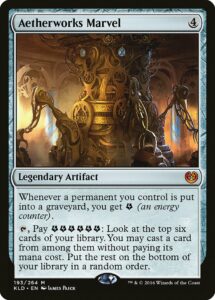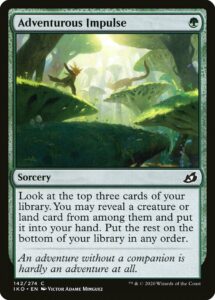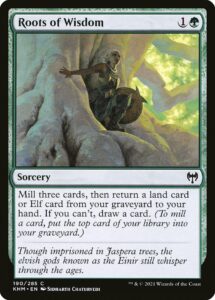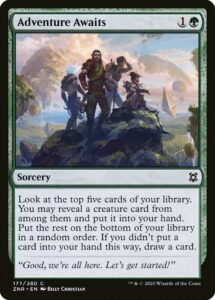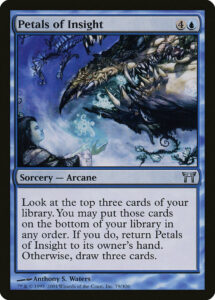Magic increasingly employs Impulse effects. You know, cards that say “look at the top N cards of your library. You get one of them.” There are plenty of flavors of and restrictions for this effect: red exiles cards from the top of your library, green only gets creatures and lands, and sometimes you mill or reveal cards rather than look at them, but they’re all Impulse effects.
It makes a lot of sense for Magic to favor Impulsing nowadays—tutors are risky business and Best of One puts more stringent demands on one’s ability to find crucial answers. Red and green have gained powerful card advantage engines (partially due to the needs of Commander) and Scry has been evergreen for years (so players of all colors are familiar with deck manipulation). Plus, Impulse is a great scaling mechanic, where you can increase available choices while keeping the number of cards gained constant.
Variance-as-cost Doesn’t Work
A few years ago, Magic introduced two of its most powerful and frustrating Impulsers ever in Aetherworks Marvel and Collected Company. In exchange for deckbuilding concessions and accepting some whims of variance, they provided enormously powerful effects at cut-rate discounts.
In the wake of those unexpectedly pushed cards, one would imagine Impulses might fall out of favor. They stopped being pushed as hard for Constructed, but we began to see more subtle innovations (Magic continued printing cards that undermined the mana system and the banhammer swung more and more often). White gained access to it with Militia Bugler. Red combined rummaging and exile-draw in Magmatic Channeler. But most recently, green made perhaps the biggest little change to the mechanic.
Risky Utility
Green possesses some of the simplest utility Impulses that suffer from the most frustrating play experiences. Adventurous Impulse vaguely resembles Ponder (and the less impressive, but twice as expensive Anticipate), a dangerous effect to replicate. Its deckbuilding cost isn’t particularly onerous—fill your deck with the two most common card types. Unfortunately, because it doesn’t look at as many cards as Once Upon a Time, there are nontrivial odds of completely failing to find anything. That brings it down from a ban-worthy cantrip to a dubious Limited playable that gets worse the better your deck’s interaction gets. While there is something exciting to gambling on how well a card performs and there is danger in formats having too much consistency, having a card completely fail to do anything—especially when it’s meant to be a utility card that increases consistency—is less than ideal game design.
Magic has created two cards which solve green’s Impulse problem in the past two sets. Each of them goes from one mana (where they risk providing far too much consistency to Standard decks) to two (where they can still be relevant in Limited). And in return, they will never, ever fail.
Mulching Around
Roots of Wisdom, like all green Impulses, puts some restrictions on what you can find. But there’s no such thing as an unlucky mill, as could be the case with Grapple with the Past. Sure, you’ll only ever put Roots of Wisdom in your deck if you have worthwhile elves to get back, since a two mana, unreliable Lay of the Land is awful (and even as it is, is still a weak card), but removing all chance of it failing to do anything is a huge improvement.
Roots of Wisdom has a nifty bit of design in that the more copies you play, the better they become, since the fuller your graveyard, the more options you have. It’s even the unusual kind of cantrip that can find you the exact same card multiple times. And perhaps the biggest advantage of Roots of Wisdom‘s design innovation is that it allows similar effects with numbers as low as only looking at one card—Adventurous Impulse was too inconsistent and weak at three cards, but remove the chance of failure and Magic doesn’t need to print such massive numbers on cards like Militia Bugler.
That said, Roots of Wisdom isn’t an elegant solution for all sets. Magic has to function with physical cards—it’s not an all-digital game where the computer confirms that you failed to find anything—so all cards must be revealed in one way or another. Players like hiding their cards and choices, and as designers, it’s good for us to avoid making cards that invite an opponent to scrutinize a player’s fully-revealed decision as they’re making it. Our second option addresses that.
Push your Luck
While Roots of Wisdom constrains half of its selection, Adventure Awaits goes further by slicing off half of Seek the Wilds (and looking at one more card). It’s a dedicated threat-searcher, rather than a flexible tool for finding lands early and threats late. Sure, if you do need a land, you can always roll the dice and cycle it, but there’s a clear bias in what it’s good at. The strong game design here is that Adventure Awaits has both a push-your-luck mechanic and a failsafe in one. If all your options are terrible or illegal, you can always cash it in for a random card (and some information about the bottom five cards of your deck). But if you’d rather have your best creature rather than the acceptable-but-unexciting best creature in your top five cards, you can always spin the wheel and dig one deeper.
As with Roots of Wisdom, Adventure Awaits isn’t a perfect solution to green’s inconsistent Impulse issue. If you give the player the freedom to cantrip whenever you like, you have to further limit its effect to offset that option. Also, I’m uncertain how well this failsafe would play if it Impulses for lower numbers. Yes, Opt is a powerful card, but would an Opt that can only hit some subset of cards be at all interesting or fun to play with?
While new mechanics and Constructed powerhouses get most of the spotlight in each release, there are plenty more quiet innovations doing good work in Limited and on kitchen tables. It’s been exciting seeing Magic address smaller problems like finding the balance between Adventurous Impulse‘s inadequacy and Collected Company‘s format-defining power. It’ll be interesting seeing what new designs Roots of Wisdom and Adventure Awaits inspire, as well as what other solutions will be introduced in time. But that’s one of the many beautiful things about Magic—new cards keep coming out, and with them, new design innovations.
And, as always, thanks for reading.
Zachary Barash is a New York City-based game designer and the commissioner of Team Draft League. He designs for Kingdom Death: Monster, has a Game Design MFA from the NYU Game Center, and does freelance game design. When the stars align, he streams Magic (but the stars align way less often than he’d like).

